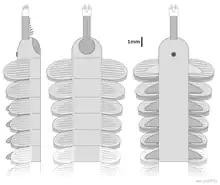Castle Bank
Castle Bank is a fossil deposit in Wales that is 462 million years old and dates from the middle Ordovician period when Mid Wales was covered by an ocean basin.[1]

Fossil discoveries
When 2020 COVID-19 lockdowns prevented Llandrindod residents and researchers for Amgueddfa Cymru – Museum Wales, Joe Botting and Lucy Muir, from travelling, they reinvestigated a site they had discovered a decade earlier in a nearby sheep field. They had failed to find the site interesting at the time because it was just a 10-meter-wide quarry.[2][3] More careful examination has revealed an exceptional find among fossils. So far, 170 species have been found, among them more than 30 panarthropods and what resembles a marine relative of insects.
Being from the middle Ordovician, the fossils coincide with the Great Ordovician Biodiversification Event. What makes these fossils differerent from those found in places such as the Cambrian fossils of the Burgess Shale is their small size. Many forms that have been found in the Castle Bank deposit are of animals who had gone through a miniaturization trend when compared to Cambrian animals found among the Burgess Shale fossils, making the biota in the Castle Bank deposit more similar to modern faunas.
Their reduced size makes it difficult to identify some of the species, as most of these fossils are just between 1 and 5 mm in body size. Nonetheless, the fossils are exceptionally well preserved, with details as small as 10 μm often being visible, including tiny limbs, digestive systems, nerves, and filter-feeding tentacles. Such details also exist among certain Cambrian fossils, but have been absent from Ordovician finds that have been discovered to date.[4][5][6][7]
References
- Tamisiea, Jack, 462-Million-Year-Old Fossil Trove Holds Miniature World of Marine Creatures, Scientific American, May 10, 2023
- "Middle Ordovician 'marine dwarf world' found in Castle Bank, Wales". Phys.org. 1 May 2023. Retrieved 4 May 2023.
- Botting, Joseph P.; Muir, Lucy A.; Pates, Stephen; McCobb, Lucy M. E.; Wallet, Elise; Willman, Sebastian; Zhang, Yuandong; Ma, Junye (1 May 2023). "A Middle Ordovician Burgess Shale-type fauna from Castle Bank, Wales (UK)". Nature. Nature Portfolio. 7 (?): 666–674. doi:10.1038/s41559-023-02038-4. PMID 37127766. S2CID 258438453. Retrieved 4 May 2023.
- Ordovician-Period Fossil Site Discovered in Wales | Sci.News
- Fossil-rich Welsh quarry yields trove of soft-bodied animals at dawn of modern life
- One of the world's greatest fossil finds made in Wales
- Fossils found in Powys 'among world's most important'
